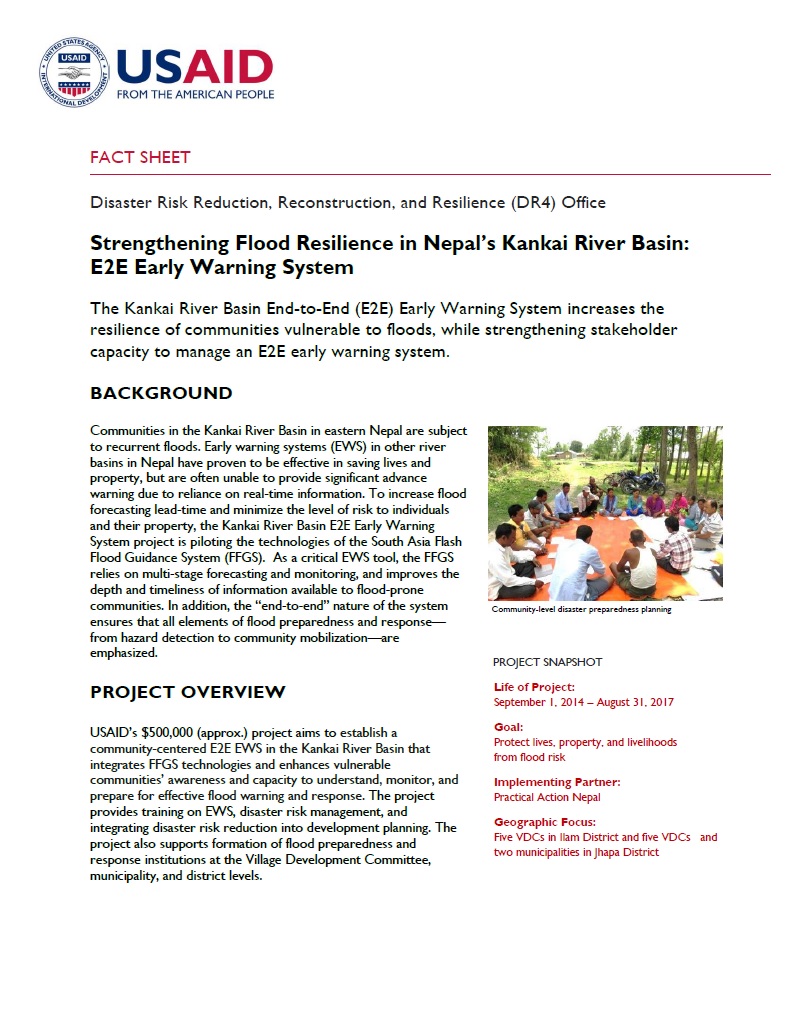Disaster Risk Reduction, Reconstruction, and Resilience (DR4) Office
Strengthening Flood Resilience in Nepal’s Kankai River Basin: E2E Early Warning System
The Kankai River Basin End-to-End (E2E) Early Warning System increases the resilience of communities vulnerable to floods, while strengthening stakeholder capacity to manage an E2E early warning system.
BACKGROUND
Communities in the Kankai River Basin in eastern Nepal are subject to recurrent floods. Early warning systems (EWS) in other river basins in Nepal have proven to be effective in saving lives and property, but are often unable to provide significant advance warning due to reliance on real-time information. To increase flood forecasting lead-time and minimize the level of risk to individuals and their property, the Kankai River Basin E2E Early Warning System project is piloting the technologies of the South Asia Flash Flood Guidance System (FFGS). As a critical EWS tool, the FFGS relies on multi-stage forecasting and monitoring, and improves the depth and timeliness of information available to flood-prone communities. In addition, the “end-to-end” nature of the system ensures that all elements of flood preparedness and response—from hazard detection to community mobilization—are emphasized.
PROJECT OVERVIEW
USAID’s $500,000 (approx.) project aims to establish a community-centered E2E EWS in the Kankai River Basin that integrates FFGS technologies and enhances vulnerable communities’ awareness and capacity to understand, monitor, and prepare for effective flood warning and response. The project provides training on EWS, disaster risk management, and integrating disaster risk reduction into development planning. The project also supports formation of flood preparedness and response institutions at the Village Development Committee, municipality, and district levels.
PROJECT OBJECTIVES
The project aims to:
- Strengthen the flood resilience of communities settled in the Kankai River Basin area and relevant stakeholders through E2E EWS
- Enhance the capacity of government and non-government organizations, along with community members, to deliver and respond to early flood warnings
PROJECT ACTIVITIES
Project activities include:
- Assessing community risk for different flooding levels in the Kankai River Basin.
- Establishing new flood and rainfall monitoring stations and upgrading existing stations.
- Responding to risks through real-time flood monitoring.
- Developing the practice of flood forecasting based on information gathered from rainfall monitoring.
- Building a risk information communication system that will benefit communities.
- Strengthening the capacity of the Nepal Department of Hydrology and Meteorology to use FFGS.
- Growing community and stakeholder capacity to respond to flood risk information.
- Constructing local and district-level disaster management plans that skillfully integrate EWS.
PLANNED RESULTS
- 5,681people (2,684 men and 2,997 women) will directly benefit from reduced hydro-meteorological hazard risks; another 113,761 people will benefit indirectly.
- Meteorological policies or procedures will be modified as a result of the activities, to increase preparedness for hydro-meteorological events.
- Flood forecasting and warning for hydro-meteorological events, including abnormal weather, heavy rainfall, and flooding, will be improved.
- Leaders and officials in relevant organizations including 50 individuals from DHM, the Nepal Red Cross Society, and district development committees will be trained in hydro-meteorological related activities.
- At least 15 female leaders will be trained in forecasting, warning, and response procedures.








Comment
Make a general inquiry or suggest an improvement.